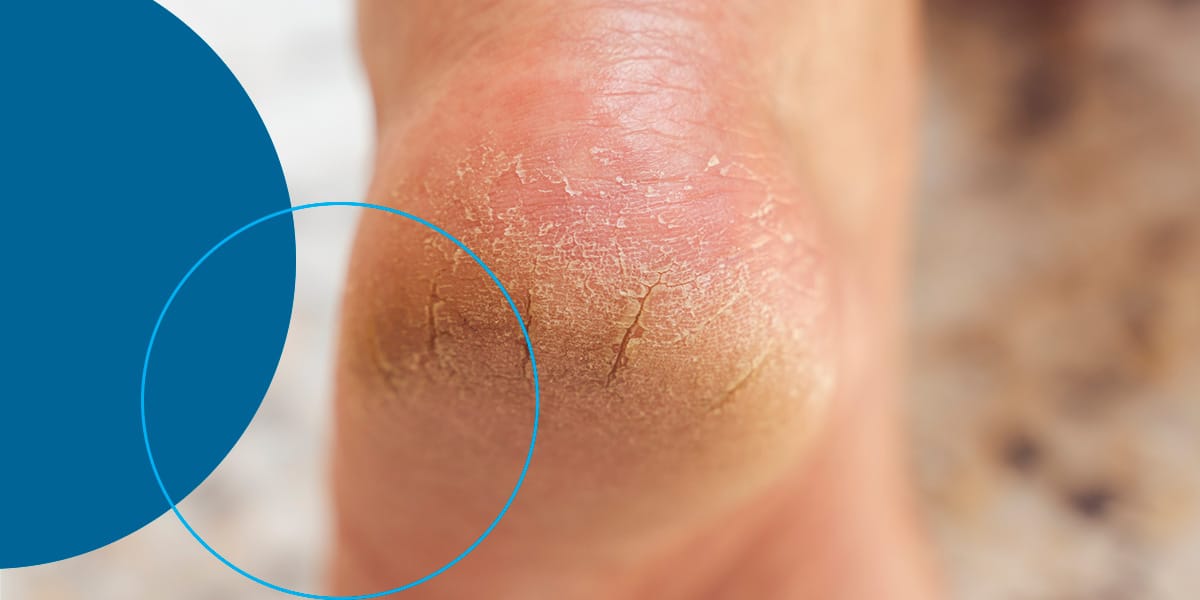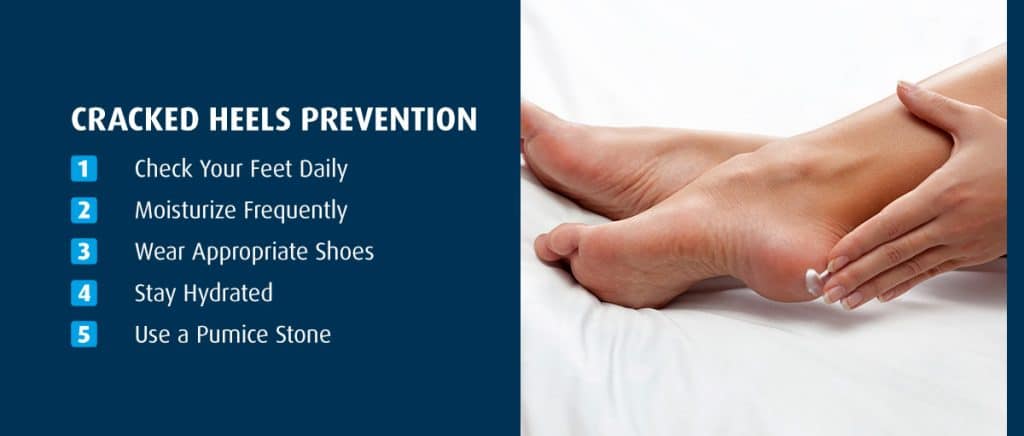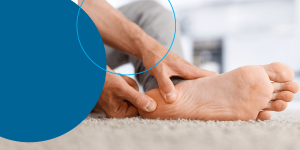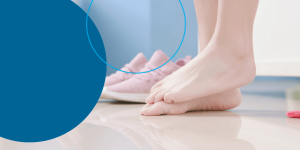
Cracked heels or fissures are visible scarring presented as hard, dry and sometimes flaky slits in the heels. It is a common, preventable condition that can lead to thick, callused and bleeding skin if left untreated. Cracked heels are unattractive and often embarrassing for those who suffer from them. More women suffer from cracked heels than men, mostly because they tend to wear shoe styles like sandals and flip-flops more often.
Learn more about how to heal cracked feet with simple remedies and care practices and how Foot & Ankle Surgical Associates can help.
Cracked Heels Causes
Cracked heels primarily result from dry skin, though there are other causes. The condition is usually harmless, but in some cases, you may notice pain and bleeding from underlying skin damage. Redness, itchiness and swelling may indicate an infection that requires immediate attention.
Medical conditions may be a contributing factor. Some of these include:
- Common fungal infections like athlete’s foot and other foot fungal infections
- Skin conditions like eczema and psoriasis
- Skin rashes and irritations, such as contact dermatitis
- Heel bone spurs that could penetrate the skin internally
- Hypothyroidism, caused by a lack of hormones produced by the thyroid
- Diabetes may aggravate symptoms associated with severely cracked heels
- Cellulitis, a skin infection that causes discoloration and swelling of the infected area
- Obesity may intensify cracked heels as excess weight forces the skin to split further
- Sjögren’s syndrome, which occurs when your body cannot produce enough moisture
Lifestyle habits also affect and cause dry, cracked heels. Lack of moisture, hot showers that dry the skin, standing for prolonged periods, wearing open-backed shoes in the heat and walking barefoot on hard surfaces lead to cracked heels. Most experience them in the summer when conditions are humid, but they can occur year-round.

Cracked Heels Treatment and Prevention
Wearing shoes like slingbacks and sandals may be embarrassing for women with cracked heels. While polished toenails are attractive, dry, callused heels can be off-putting. Avoiding cracked heels may mitigate these awkward situations. If you have dry heels, we’ve listed five techniques to help prevent them from cracking.
1. Check Your Feet Daily
Check your feet and heels for signs of cracking each morning and before bedtime. Run your hands over them and inspect the heels for roughness and dryness.
2. Moisturize Frequently
With exposure to heat and direct surfaces, the heels may dry out faster than other areas like the hands, elbows and knees. Many people neglect their feet when applying moisturizer.
Applying a generous amount of cracked heels cream or your favorite lotion will help keep your feet supple and soft, especially after washing and drying them thoroughly before bedtime. Put on socks to retain the moisture.
3. Wear Appropriate Shoes
The correct footwear will help you prevent and manage cracked heels, especially in the summer when you’re more likely to experience this issue. You might gravitate toward your favorite sandals and flip-flops in the summer, but try to wear closed-back shoes to protect your heels from dryness. Most shoe stores sell various styles to accommodate for all tastes and preferences.
Limit flip-flops and slides, which don’t provide sufficient support and could lead to other foot problems over time. If you wear closed shoes, also wear cotton socks, use custom orthotics for cushioning and don’t stand for long periods. Foot powder is beneficial to prevent excessive sweating when you wear workout shoes.
4. Stay Hydrated
Water helps the skin retain elasticity and moisture, so keep a canteen nearby throughout the day to stay hydrated.
5. Use a Pumice Stone
Exfoliating your feet daily with a pumice stone is another way to prevent cracked heels from forming. Avoid rough, abrasive files that could tear your skin. Pumice is gentle enough to remove dead skin cells without causing damage.
Cracked Heel Remedies
If you suffer from cracked heels, there are treatments to alleviate the pain. In severe cases, you may need to consult a podiatrist to diagnose the extent and offer professional treatment options.
Meanwhile, here are DIY home remedies you can try to fix cracked heels.
- Moisturizing heel balms: Implementing and sticking to a daily moisturizing routine can help reduce dryness, fill cracks and form a barrier to prevent moisture loss. Look for ingredients like collagen, elastin, aloe, cocoa butter and fruit oils.
- Exfoliating foot peel: A foot peel mask is a painless way to remove dead skin. Wear the booties for about an hour, allowing the ingredients to soak into your feet. A few days later, the old skin will start peeling off by itself until only new, soft feet remain.
- Coconut oil: Massaging your heels and feet with coconut oil is beneficial due to its inherent healing properties. It helps stimulate blood flow, which promotes faster healing if you suffer from acute pain.
- Epsom salt soaks: Soaking your feet in water containing Epsom salt for 15 minutes daily helps exfoliate and soften them. It is also effective in fighting infections. Rub your feet together and scrub the salt on your heels to remove dead skin cells. Soak for about 10 more minutes and rinse it with clean water. For optimal smoothness, pat your feet dry and apply a moisturizing balm.
- Natural ointments and aqueous cream: Soothing creams like aqueous cream and natural ointments with infection-fighting properties reduce dry skin with regular application.
A podiatrist may suggest a callous debridement, which entails removing built-up skin from your heels with a scalpel as a preventive measure.
Tips for Maintaining Heel Health
Maintaining good heel health will prevent and treat cracked skin and improve your overall well-being. Consider these tips.
- Eat a balanced diet: Choose foods rich in nutrients, fatty acids, vitamins and minerals to promote skin vigor and elasticity. Drink lots of water to further promote skin elasticity.
- Adopt an exercise regimen: Exercising encourages fitness and blood circulation. With regular workouts, you may notice an improvement in your foot and general health.
Seek Professional Help With Foot & Ankle Surgical Associates
No one has to live with the burden and pain of inflamed, bleeding heels. A cracked heels home remedy might offer a temporary solution. However, you may have underlying issues perpetuating the problem. A podiatrist can examine your feet to determine the cause of severely cracked and infected heels. If it’s medical, they can prescribe effective treatment or surgery.
If you’d like to consult with one of our expert podiatrists, call us at 360-795-5462 or email marketing@anklefoot.net with your question and we’ll reply as soon as possible.




